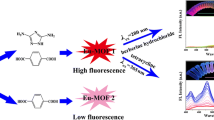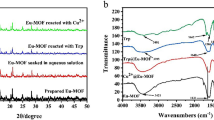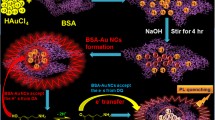Abstract
In the present experiment, a new metal–organic framework (MOF) containing Eu(III) of {[Eu(CA)(OA)0.5(H2O)2]·H2O}n (1, in which H2OA = oxalic acid and H2CA = chelidonic acid) has been generated by using the solvothermal reaction approach. The as-prepared Eu-MOF was investigated for the high sensitive detection performance for the p-nitroaniline, a harmful chemical in food and water. As a kind of luminescent sensor, the Eu-MOF reflects an obvious fluorescent quenching toward the p-nitroaniline, while other similar nitroaromatic compounds only show weak quenching effects. To relieve the stigma and mental disorders in syphilis patients, the dopamine content in cerebrospinal fluid was detected by the enzyme-linked immunosorbent detection kit after the compound treatment. In addition to this, the real-time reverse transcription polymerase chain reaction was also implemented for the detection of the dopamine receptor relative expression levels in the striatum.






Similar content being viewed by others
Data availability
The data used to support the findings of this study are included within the article.
References
L. Sheehan, K. Nieweglowski, P. Corrigan, Curr. Psychiatry Rep. 18, 11 (2016)
E. Avdibegović, M. Hasanović, Psychiatr. Danub. 29, 900 (2017)
F. Hanschmidt, K. Linde, A. Hilbert, S.G. Riedel-Heller, A. Kersting, Perspect Sex Reprod. Health 48, 169 (2016)
J.N. Hao, B. Yan, Nanoscale 8, 12047 (2016)
D. Yuan, M. Sun, M. Zhao, S. Tang, J. Qi, X. Zhang, K. Wang, B. Li, Int. J. Electrochem. Sci. 15, 8761 (2020)
N. Jiang, Y. Liu, X.N. Yu, H.B. Zhang, M.M. Wang, Int. J. Electrochem. Sci. 15, 5520 (2020)
J.X. Li, Z.X. Du, J. Coord. Chem. 69, 2563 (2016)
J.X. Li, Z.X. Du, Z. Naturforsch. 70b, 505 (2015)
Z.X. Du, J.X. Li, Inorg. Chim. Acta 436, 159 (2015)
C. Duan, Z. Su, Y. Cao, L. Hu, D. Fu, J. Ma, Y. Zhang, J. Clean. Prod. 283, 124635 (2021)
Y. Cui, B. Chen, G. Qian, Coord. Chem. Rev. 273–274, 76 (2014)
A. Cadiau, C.D.S. Brites, P.M.F.J. Costa, R.A.S. Ferreira, J. Rocha, L.D. Carlos, ACS Nano 7, 7213 (2013)
C.B. Yang, C.B. Jiang, M.Y. Zhang, X. Chen, P. Zou, R.W. Yang, H.B. Rao, G.T. Wang, Polyhedron 175, 114216 (2020)
X. Liang, Y. Jia, Z. Zhan, M. Hu, Appl. Organomet. Chem. 33, 15399 (2019)
J.M. Liu, J.X. Hou, J. Liu, X. **g, L.J. Li, J.L. Du, J. Mater. Chem. C 7, 11851 (2019)
K. Wu, J. Hu, S. Shi, J. Li, X. Cheng, Dye. Pigment. 173, 107993 (2020)
D.M. Chen, N.N. Zhang, C.S. Liu, M. Du, ACS Appl. Mater. Inter. 9, 24671 (2017)
F. Zhang, G. Zhang, H. Yao, Y. Wang, T. Chu, Y. Yang, Microchim. Acta 184, 1207 (2017)
M. Dejneka, E. Snitzer, R.E. Riman, J. Lumin. 65, 227 (1995)
X.S. Gao, J.T. Wang, Inorg. Chim. Acta 386, 1 (2012)
P. Wu, Y. Liu, Y. Li, M. Jiang, X. Li, Y. Shi, J. Wang, J. Mater. Chem. A 4, 16349 (2016)
D.M. Chen, J.Y. Tian, Z.W. Wang, C.S. Liu, M. Chen, M. Du, Chem. Commun. 53, 10668 (2017)
M.Y. Sun, D.M. Chen, H. Zhang, Inorg. Chem. Commun. 73, 103 (2016)
Z. Cao, L. Chen, S. Li, M. Yu, Z. Li, K. Zhou, C. Liu, F. Jiang, M. Hong, Chem. Asian J. 14, 3597 (2019)
Author information
Authors and Affiliations
Corresponding author
Supplementary information
Below is the link to the electronic supplementary material.
Rights and permissions
About this article
Cite this article
Feng, LJ., Yuan, AQ., Li, YY. et al. A Eu (III) metal–organic framework as sensitive fluorescent sensor for p-nitroaniline, treatment activity on the stigma and mental disorders in syphilis patients by regulating the dopamine content in the brain. J IRAN CHEM SOC 18, 2605–2612 (2021). https://doi.org/10.1007/s13738-021-02214-y
Received:
Accepted:
Published:
Issue Date:
DOI: https://doi.org/10.1007/s13738-021-02214-y




